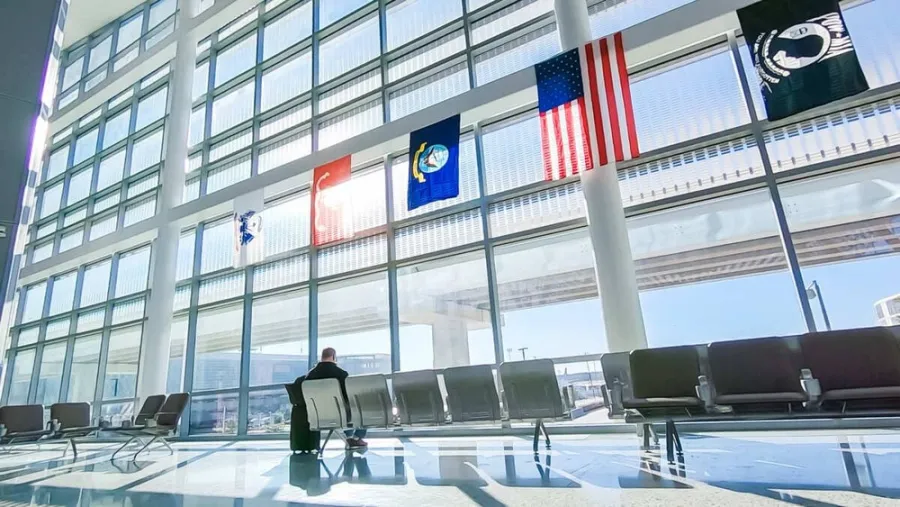Change language
The biggest airports in the USA: A complete overview
November 19, 2024

Airports are more than just gateways to cities, countries, and continents; they are complex infrastructures that fuse architecture, engineering, and technology together. In this article, we will walk you through the ten largest airports in the United States. From Denver International Airport's sprawling 135.69km² area in Colorado to Detroit Metropolitan Airport's 19.6km² expanse in Michigan, these behemoths of transportation are fascinating in their own right.
1. Denver International Airport (DEN), Colorado: 135.69km²
Denver International Airport (DEN), located in the heart of Colorado, is the largest airport in the United States and North America by total land area. Spreading over an impressive 135.69km², or 52.4 square miles, it's vast in scale and yet manages to efficiently handle a large volume of passengers. In 2023, the airport was the gateway for 77.8 million passengers, making it the 3rd busiest airport in the US and the 6th busiest in the world.
Despite its size, the airport's runway configuration is a marvel of design and engineering. It has six runways, each spaced 4,200ft apart, allowing for efficient traffic flow. One of these runways, the 16R/34L, holds the distinction of being the longest public-use runway in the United States at 16,000ft. Skytrax, a global air transport rating organization, acknowledged the airport's excellence in 2018, ranking it as the 29th best airport in the world. It was the highest-ranking any US airport had achieved at the time.
The 139,000m² (34.34-acre) Jeppesen Terminal is the heart of the airport's landside facilities. Divided into East and West terminals, it spans three passenger levels and is the primary hub for all check-ins and arrivals. Passengers can access Concourse A via a footbridge, while automated guideway trains connect to concourses B and C. In 2021, a modernisation project was completed, adding new check-in counters, screening areas, and commercial spaces to the terminal. [1]
However, every coin has two sides, and Denver International Airport is no exception. Despite its size and modern facilities, it has been criticized for challenges such as difficult navigation and overcrowding. Additionally, despite efforts to optimize for adverse weather conditions, significant delays can still occur during severe weather. This can be frustrating for passengers, but it's important to remember that you may be entitled to compensation for a delayed flight.
Here are some quick facts about Denver International Airport:
- Size: 135.69km² (52.4 square miles)
- Passenger volume in 2023: 77.8 million
- Runways: 6
- Longest public-use runway in the US: 16,000ft
- Skytrax ranking in 2018: 29th best airport in the world
- Jeppesen Terminal size: 139,000m² (34.34-acre)
2. Dallas Fort Worth International Airport (DFW), Texas: 69.63km²
The Dallas Fort Worth International Airport (DFW), situated between the cities of Dallas and Fort Worth in Texas, is a testament to the grandeur of the US aviation industry. Covering a massive area of 69.63km², or 26.9 square miles, this airport is the second-largest in the US by area. Housing five terminal buildings and a total of 174 gates, DFW is quite an impressive sight to behold. As of 2023, it ranked as the third busiest airport globally, serving over 80 million passengers.
One of the key features of DFW is the Skylink Automated People Mover System. This advanced transportation system links the five terminals, conveniently named A to E. The Skylink runs right through DFW's Express South car park, which has been designed to accommodate the future Terminal F, set to open in 2025. This marks DFW's commitment to future expansion and technological advancements.
The airport's significant size and advanced facilities allow it to handle a high volume of passengers efficiently. In 2023, DFW served over 80 million passengers, marking it as the third busiest airport in the world. This fact underlines the airport's capacity to handle large volumes of passengers efficiently. [2]
3. Orlando International Airport (MCO), Florida: 53.83km²
With its expansive size of 53.83km², it ranks as the third largest airport in North America. The airport's history dates back to 1942 when it was initially opened as McCoy US Air Force Base for military operations. After successfully handling five million passengers in 1978, it was designated as an international airport for civil use in 1976.
The airport's massive size is matched by a high volume of passenger traffic. In 2023, MCO facilitated more than 57 million passengers and 405,925 aircraft movements. Such figures not only reflect the airport's capacity to handle a substantial volume of passengers and aircraft traffic but also its vital role in the aviation industry.
It's important to note that, while the airport strives for smooth operations, delays and mishaps, such as lost luggage, can occasionally occur. In such cases, passengers are advised to check with their airline regarding compensation policies. Many airlines offer compensation for lost luggage, and understanding these policies can help travelers navigate such situations more effectively.
The airport's terminal structure is designed for efficient handling of its immense passenger traffic and operations. The main landside building houses two terminals, A and B. Terminal A, the northern side of the building, leads to Airside 1 and Airside 2. On the other hand, the southern Terminal B links to airsides 3 and 4.
Here are some additional facts about MCO:
- MCO is a major hub for Southwest Airlines and Spirit Airlines.
- It offers non-stop flights to more than 135 destinations.
- In addition to commercial services, MCO also supports significant cargo operations. [3]
4. Washington Dulles International Airport (IAD), Washington DC: 52.6km²
Washington Dulles International Airport (IAD) sits prominently among the largest airports worldwide, with a coverage of about 52.6km² or 20.3 square miles. Nestled in Virginia, the airport is conveniently situated 26 miles west of Washington DC. This strategic location significantly contributes to its heavy annual traffic.
In 2023, IAD proudly served approximately 25 million passengers, securing its place as the 28th busiest airport in North America. The airport boasts a main terminal building, two midfield terminals, and four concourses overall. A notable expansion in 2009 of the arrivals building enhanced the airport's capacity, allowing it to process up to 2,400 passengers per hour.
The layout of IAD is designed with passenger comfort and efficiency in mind. Concourses A and B, located nearest to the main terminal, primarily cater to international travel and domestic flights not operated by United Airlines. Concourses C and D, on the other hand, are exclusively utilized by United Airlines, providing passengers with a seamless travel experience.
Some key points about IAD:
- It is one of the largest airports worldwide, covering 52.6km² or 20.3 square miles.
- It is strategically located 26 miles west of Washington DC.
- In 2023, IAD served approximately 25 million passengers.
- The airport has a main terminal building, two midfield terminals, and four concourses.
- The AeroTrain system efficiently connects the main terminal with the concourses. [4]
5. George Bush Intercontinental Airport (IAH), Texas: 40.46km²
Situated 37km north of Houston, Texas, George Bush Intercontinental Airport (IAH) is the fifth largest airport in the United States. It covers an expansive area of 40.46km² (15.6 square miles). Owned by the City of Houston, this massive airport serves as a crucial transport hub, playing a significant role in the national and international air travel.
You might be surprised to learn that IAH is the second largest hub for United Airlines in the country. It falls just behind Chicago’s O’Hare International Airport in terms of scale. In 2023, IAH served over 46 million passengers and saw an impressive 399,805 aircraft movements. These figures attest to its bustling operations and high traffic.
IAH is organized into five terminals (A-E), each serving various airlines. Three main entrances lead to these terminals, offering easy access to travelers. Terminal D, also known as the Mickey Leland Terminal, is particularly noteworthy. It operates as an international arrivals location and features common-use gates and check-in desks for more than 30 airlines. This makes it a central hub within the airport, bustling with passengers from all over the world. [5]
Want to know the situation in Europe? Here are the top 11 biggest airports in Europe!
6. Salt Lake City International Airport (SLC), Utah: 31.16km²
Salt Lake City International Airport (SLC) in Utah spans over an impressive 31.16km², which is roughly equivalent to 12 square miles. It is conveniently located only four miles west of the city, making it a critical hub for transportation in the region. The airport boasts four runways and three helipads, which allows it to handle a substantial amount of traffic.
SLC is easily accessible from the city via the Utah Transit Authority’s TRAX system. This connection was extended in 2013 to better accommodate commuters and travelers alike. Additionally, the airport offers park-and-ride facilities for visitors. This service provides a cost-effective alternative to airport parking, which can often be expensive and inconvenient.
Despite not being the busiest airport on our list, SLC has still seen a significant amount of traffic. As of 2023, over 26 million passengers passed through its terminals. Since its establishment in 1960, the airport has experienced considerable growth. This increase in traffic necessitated expansion, a process that has been ongoing since 2014.
A unique feature of SLC is its military use. Over 500,00m² (123.6 acres) of the airport’s land is leased to the US Government for military operations. Specifically, it serves as the Roland R Wright Air National Guard Base. This dual-use aspect adds another layer of complexity and significance to the airport's operations.
Here are a few key points to remember about Salt Lake City International Airport:
- It's located just four miles west of Salt Lake City.
- The airport spans over 31.16km² and includes four runways and three helipads.
- It's easily accessible via the Utah Transit Authority’s TRAX system.
- Over 26 million passengers used the airport in 2023.
- A significant part of the airport’s land is leased for military operations. [6]
7. O’Hare International Airport (ORD), Illinois: 30.86km²
Located in the northwest metropolitan area of Chicago, Illinois, this airport spans an impressive 30.86km². As the 9th busiest airport globally, ORD is a bustling hub that handled over 73 million passengers and experienced a staggering 720,582 aircraft movements in 2023.
O'Hare International Airport boasts four terminals and nine concourses. Terminals 1, 2, and 3 are designated for domestic flights and journeys to destinations with border clearance. As for Terminal 5, it is reserved for all international arrivals, equipped with customs screening to ensure the smooth transition of passengers from abroad.
One of the key projects that sets ORD apart is the ambitious O’Hare 21 expansion plan. This includes the demolition of the current terminal and the construction of the state-of-the-art O'Hare Global Terminal. The plan further involves the reconstruction of gates and concourses to increase capacity, with a total of 235 gates planned. This will significantly improve the flow of passengers and aircraft, enhancing the overall airport experience. Additionally, ORD serves as a hub for numerous charter airlines, offering a diverse range of travel options for both leisure and business travelers. [7]
8. San Francisco International Airport (SFO), California: 21.07km²
San Francisco International Airport (SFO), located just 13 miles south of downtown San Francisco, California, is the eighth-largest airport in the United States. Spanning an impressive 21.07 square kilometers, or 8.1 square miles, it is a significant hub for both domestic and international flights. In 2023, SFO served more than 50 million passengers, making it the 14th busiest airport in the United States and the 30th busiest in the world.
The airport is divided into four terminals. The International Terminal, which opened in the year 2000, was the largest international airport terminal in North America at that time. It was also the first terminal to have gates capable of accommodating the large Airbus A380 double-decker aircraft. The Harvey Milk Terminal, once known as Terminal 1 or the South Terminal, underwent a renovation project that started in 2016 and was completed in 2021.
Terminal 2, the oldest terminal in the airport, opened its doors in 1954 and has since undergone several renovations to keep up with modern demands and technologies. Terminal 3, used by United Airlines for domestic flights, consists of boarding areas E and F, which houses a total of 39 gates.
Key facts about SFO:
- Size: 21.07 square kilometers (8.1 square miles)
- Location: 13 miles south of downtown San Francisco
- Terminal Information: four terminals, with the International Terminal being the largest
- Passenger Traffic: over 50 million passengers in 2023, ranking 14th in the US and 30th in the world
- Airlines: served by numerous airlines, with United Airlines operating domestic flights from Terminal 3. [8]
9. John F Kennedy International Airport (JFK), New York: 21.04km²
The John F Kennedy International Airport (JFK) in New York, covering an impressive 21.04km² or 8.1 square miles, is the largest airport in the state. It boasts six terminals, 128 operational gates, and four runways. Its capacity is immense, having handled over 62 million passengers in 2023. This makes JFK the 6th busiest airport in the US.
JFK's terminal use and management is quite diverse. The airport initially had ten terminals, but some were demolished and restructured. At present, Terminal 1 is operated by the SkyTeam Alliance along with other airlines. Terminal 2 is fully utilized by Delta Air Lines, which operates its main international flights from Terminal 4.
Terminal 5 is operated and managed by JetBlue Airways and is used by multiple other airlines. British Airways operates Terminal 7 under a lease agreement with the airport that is valid until 2022, with an option to extend for a further three years.
Terminals 8 and 9 were merged to form the new Terminal 8, which is twice the size of Madison Square Garden. This new terminal was opened in stages between 2005 and 2007 and now serves as a major hub within the airport. [9]
10. Detroit Metropolitan Airport (DTW), Michigan: 19.6km²
Detroit Metropolitan Airport (DTW), located in Michigan, covers an impressive area of 19.6km² (7.6 square miles). Its genesis traces back to 1929 when it was built on a land area of 2.6km² (one square mile), bought by Wayne County, which continues to own the airport today.
A bustling hub of activity, DTW in 2023 handled an impressive 31.4 million passengers and recorded 290,238 aircraft movements. It's important to note that, while airports strive for smooth operations, delays and cancellations can sometimes occur. In such cases, passengers are advised to familiarize themselves with their airline's policies regarding compensation for canceled flights.
The airport boasts two terminals and six runways. The McNamara Terminal is the larger of the two and features three concourses with 103 gates. Delta Air Lines and its partners, Aeromexico and Air France, predominantly use these gates. Twelve of these are designated for international boarding, with ten enabled for dual jet bridge loading and unloading, which streamlines the deplaning process. The B and C Concourses connect to Concourse A through a tunnel adorned with a decorative color-changing light installation. [10]
Looking towards the future, these airports are likely to undergo significant changes. Technological advancements could lead to more efficient flight operations and passenger processing. Increasing passenger traffic may necessitate further expansion or the development of innovative solutions to handle the growth. Changing travel trends, such as the rise of low-cost carriers or the increasing demand for sustainable travel options, could also shape the future of these airports.
Sources
[1] Wikipedia Contributors. “Denver International Airport.” Wikipedia, Wikimedia Foundation, 15 Oct. 2024, en.wikipedia.org/wiki/Denver_International_Airport. Accessed 25 Oct. 2024.
[2] Wikipedia Contributors. “Dallas Fort Worth International Airport.” Wikipedia, Wikimedia Foundation, 21 Oct. 2024, en.wikipedia.org/wiki/Dallas_Fort_Worth_International_Airport#:~:text=In%202023%2C%20DFW%20served%2081%2C764%2C044,the%20airport’s%2050%2Dyear%20history. Accessed 25 Oct. 2024.
[3] Wikipedia Contributors. “Orlando International Airport.” Wikipedia, Wikimedia Foundation, 24 Oct. 2024, en.wikipedia.org/wiki/Orlando_International_Airport. Accessed 25 Oct. 2024.
[4] Wikipedia Contributors. “Dulles International Airport.” Wikipedia, Wikimedia Foundation, 25 Oct. 2024, en.wikipedia.org/wiki/Dulles_International_Airport. Accessed 25 Oct. 2024.
[5] Wikipedia Contributors. “George Bush Intercontinental Airport.” Wikipedia, Wikimedia Foundation, 23 Oct. 2024, en.wikipedia.org/wiki/George_Bush_Intercontinental_Airport. Accessed 25 Oct. 2024.
[6] Wikipedia Contributors. “Salt Lake City International Airport.” Wikipedia, Wikimedia Foundation, 24 Oct. 2024, en.wikipedia.org/wiki/Salt_Lake_City_International_Airport. Accessed 25 Oct. 2024.
[7] Wikipedia Contributors. “O’Hare International Airport.” Wikipedia, Wikimedia Foundation, 23 Oct. 2024, en.wikipedia.org/wiki/O%27Hare_International_Airport. Accessed 25 Oct. 2024.
[8] Wikipedia Contributors. “San Francisco International Airport.” Wikipedia, Wikimedia Foundation, 16 Oct. 2024, en.wikipedia.org/wiki/San_Francisco_International_Airport. Accessed 25 Oct. 2024.
[9] Wikipedia Contributors. “John F. Kennedy International Airport.” Wikipedia, Wikimedia Foundation, 23 Oct. 2024, en.wikipedia.org/wiki/John_F._Kennedy_International_Airport. Accessed 25 Oct. 2024.
[10] Wikipedia Contributors. “Detroit Metropolitan Airport.” Wikipedia, Wikimedia Foundation, 11 Oct. 2024, en.wikipedia.org/wiki/Detroit_Metropolitan_Airport. Accessed 25 Oct. 2024.
More travel blog recommendations

Turn your delayed, cancelled or overbooked flight into a compensation up to €600!
Flight delay compensation canceled
Flight refund for a canceled or delayed flight
Flight compensation
©2025 AirClaim.com - All rights reserved Air Claim SA - Bdul. Pipera 1/Vi Bl. HYPERION TOWERS Et. 3 SP. BIR. 3 Cod 077190, Voluntari, Ilfov, România

















